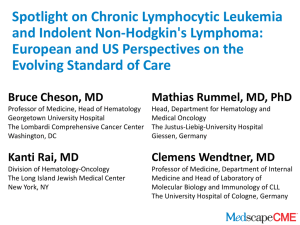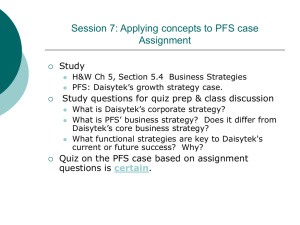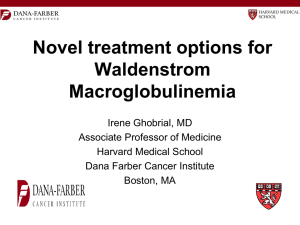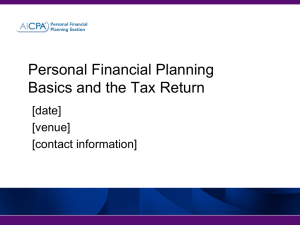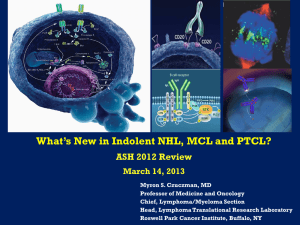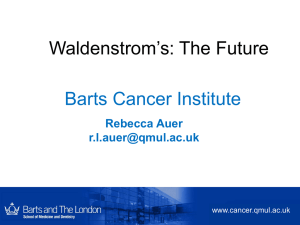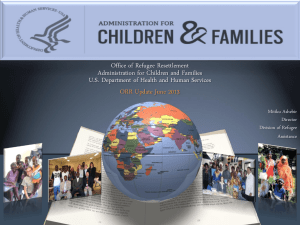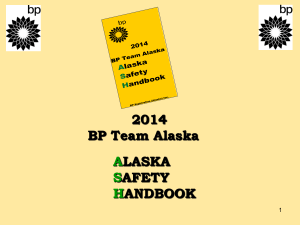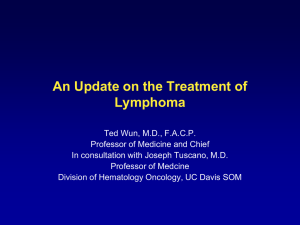Indolent Lymphomas, Mantle Cell Lymphomas & T-Cell
advertisement
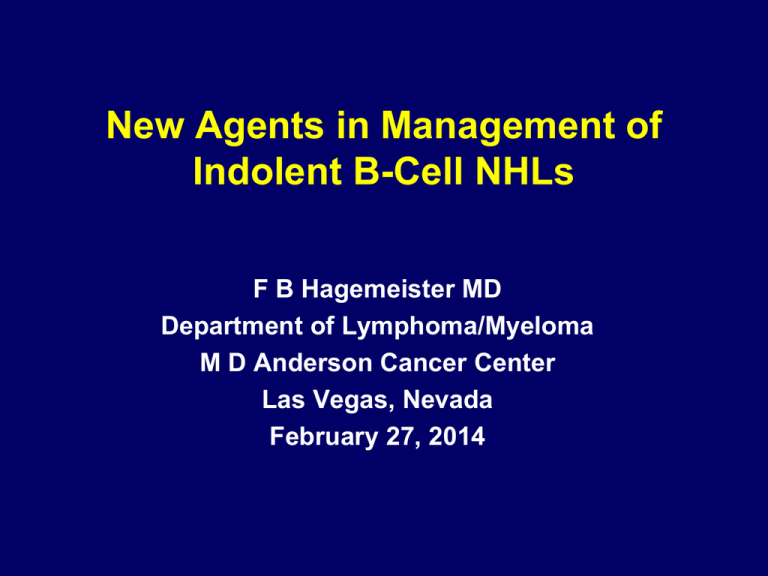
New Agents in Management of Indolent B-Cell NHLs F B Hagemeister MD Department of Lymphoma/Myeloma M D Anderson Cancer Center Las Vegas, Nevada February 27, 2014 New Agents in Management of Indolent B-Cell NHLs • • • Monoclonal Antibodies • Rituximab • Ofatumumab • Obinutuzumab Protein Inhibitors • BTK Inhibitors • PI3K Inhibitors • Others Immunomodulatory Agents Phase III MR, 2 Schedules, for Untreated FL Following SA Rituximab x 4: SAKK 35/03 • Med PFS: (MR = 4 doses, vs 5 years, both q 2 mo): – For all 165 enrolled: A-3.4 yr vs B-5.3 (p=0.14) – Thought due to higher relapse rate before MR begun for those in Gp A for “unexplained reasons” – For only those in remission at 8 mo: A-7.1 yr vs B2.9 (p=0.004) • Gr 3-4 infections (Pt): A-1 vs B-5 • No differences in OS or ORR • Conclusion: If in remission after SA Rituximab, MR prevents relapse if given longer vs shorter interval Taverna et al, ASH 2013, # 508 But best duration of MR is still unclear. The PRIMA Trial: A 6 Year Update • Med f/u 73 months (from randomization) • 6 year PFS results: – 60% with R vs 42% without R (p<0.0001) • Favorable features affecting PFS by MVA: Feature HR P Value Maintenance R 0.47 <0.0001 FLIPI 0-2 0.67 <0.0001 Female 0.72 0.0003 Age over 60 0.79 0.015 • OS rates, transformation rates not different • Still No result on differences related to type of chemotherapy administered Salles et al. ASH 2013, # 509. MR vs Obs after R-Chemo for FL: PFS in the PRIMA Trial Progression-Free Survival 24 72 Months Salles et al. ASH 2013 # 509 Early Relapse Of R-CHOP for FL: Effect of Early Relapse on OS Result Early Relapse in Lymphocare Study: <2 yrs from diagnosis (21% of 588 pts) By MVA: ER Associated with High LDH, PS > 1, Marrow DZ, and B Sx. Casulo et al. ASH 2013 # 510 90Y-Ibritumomab for Advanced Stage FL in First Remission: The FIT trial Med PFS Results (Mo) Control 90Y I P HR Patients in CR (%) 53.3 87.4 NR NR All Pts 13.5 37 <0.0001 0.46 Initial PR 6.3 29.7 <0.0001 0.30 Initial CR 29.9 54.6 .01 0.61 24.1 NR 0.05 0.6 2 11.3 53.9 <0.1 0.23 3-5 6.5 23.8 0.08 0.59 FLIPI, 0-1 *Note: All patients Only 10-15% had received induction rituximab. A second randomized trial was planned with induction R-CHOP . High-risk pts receive RIT vs SCT, low risk receive RIT vs Obs. All would receive maintenance rituximab. But trial abandoned Hagenbeek et. al. ASH 2007, Abstract # 693 90YIbritumomab Consolidation vs MR for Untreated FL in CR/PR After R-CHOP Conclusion: MR is better than 90YIbritumomab after R-CHOP Lopez-Guillermo, et al. ASH 2013 # 369 New Agents in Management of Indolent B-Cell NHLs • • • Monoclonal Antibodies • Rituximab • Ofatumumab • Obinutuzumab Protein Inhibitors • BTK Inhibitors • PI3K Inhibitors • Others Immunomodulatory Agents Novel Anti-CD20 MoAbs for Relapsed/Refractory Indolent Lymphomas MoAb Phase Efficacy I/II Dose (ORR): 300 mg (63%); 500 mg (33%); 700 mg (20%); 1000 mg (50%) II ORR: 11%, 6-mo PFS in 116 pts with rituximab-refractory FL Ofatumumab IV administration: ORR: 44%, CR: 27% DOR in pts with FL: 19.7 mos Veltuzumab I/II Ocrelizumab I/II ORR: 38%; PFS: 11.4 mos in pts with FL I/II/III ORR: 69%, CR: 38% in 13 pts with FL GA101 Subcutaneous administration: ORR: 53% CR: 20% in pts with indolent NHL Morschhauser. Ann Oncol. 2010; Morschhauser. JCO. 2009;27: 3346; Negrea. ASH. 2009 (abstr 3757); Hagenbeek. ASH. 2009 (abstr 935); Hagenbeek. Blood. 2008;111:5486; Salles. ASH. 2009 (abstr 1704). New Agents in Management of Indolent B-Cell NHLs • • • Monoclonal Antibodies • Rituximab • Ofatumumab • Obinutuzumab Protein Inhibitors • BTK Inhibitors • PI3K Inhibitors • Others Immunomodulatory Agents Obinutuzumab vs Rituximab for Rel iNHL: The GAUSS Study • 175 pt with rel CD20 pos iNHL, 149 had FL • Eligibility: CR or PR to rituximab-based therapy with response lasting > 6 months • Features: Median 2 prior Txs, others balanced • Therapy: G 1000 mg q wk X 4 or R X4. 4-6 wks later, pt with CR,PR,SD could receive drug q 2 mo X 2 yrs • Infusion-related RXNs more common with GA-101 (72% vs 49%, any Gr) • By IR panel, OR for all: G-42% vs R-24%; for FL: G-43% vs R-28% Sehn et al. ASH 2011, abst 269. Obinutuzumab plus FC or CHOP for Rel/Ref FL: Phase I GAUDI Study • Obinutuzumab (GA-101): glycosylated, Type II moab against CD20 • 56 pt, stratified by prior therapy • Two Ob regimens chosen based on phase I trial: 1600 mg d 1+8, cycle 1, then 800 mg d 1+8 vs 400/400 for max 8 (CHOP) or 6 (FC) cycles • Toxicity: Not increased with higher doses of Ob • Results: OR=96% (G-CHOP), 93% (G-FC) CR=39%(G-CHOP), 50% (G-FC) • Basis for new G-CHOP study vs R-CHOP for untreated FL Radford et al: ASH 2011, abst 270. Novel Therapeutics for Cancer Cancer Hallmark Therapeutic Target Treatment Proliferation Syk, Btk, PKCB, MToR, PI3K FosD, PCI-32765, Enzastaurin, Temsirolimus, Idelalisib Insensitive to Growth Inhibition HDAC, DNMT Vorinostat, Romidepsin, Belinostat, Panabinostat, Vidaza Evading apoptosis BCL2/BCLX, MCL-1, Survivin ABT-263, Obatoclax, YM155 Limitless Replication CDK, PARP AT7519, AZD7762, AT9283 Neoangiogenesis VEGFR, FGFR Sorafenib, Imatinib, Sunitinib Invasion/Metastasis Src, Fak, TGF Dasatinib, LY2109761, XL228 Immune Evasion NK/T cells Lenalidomide, Pomalidomide Stress Response Proteasome Bortezomib, Carfilzomib Stromal Subversion SHh, Wnt, Notch GDC-0449, XL139, XAV939, MK-0752 Cytokine Response CXCR4, IL-21R AMD3100, BKT140, IL-21 Mahadavan and Fisher. JCO 29: 1876, 1884, 2011. Novel Therapeutics for NHLs Cancer Hallmark Therapeutic Target Treatment Proliferation Syk, Btk, PKCB, MToR, PI3K FosD, Ibrutinib, Enzastaurin, Temsirolimus, Idelalisib Insensitive to Growth Inhibition HDAC, DNMT Vorinostat, Romidepsin, Belinostat, Panabinostat, Vidaza Evading apoptosis BCL2/BCLX, MCL-1, Survivin ABT-263, Obatoclax, YM155 Limitless Replication CDK, PARP AT7519, AZD7762, AT9283 Neoangiogenesis VEGFR, FGFR Sorafenib, Imatinib, Sunitinib Invasion/Metastasis Src, Fak, TGF Dasatinib, LY2109761, XL228 Immune Evasion NK/T cells Lenalidomide, Pomalidomide Stress Response Proteasome Bortezomib, Carfilzomib Stromal Subversion SHh, Wnt, Notch GDC-0449, XL139, XAV939, MK-0752 Cytokine Response CXCR4, IL-21R AMD3100, BKT140, IL-21 Mahadavan and Fisher. JCO 29: 1876, 1884, 2011. New Agents in Management of Indolent B-Cell NHLs • • • Monoclonal Antibodies • Rituximab • Ofatumumab • Obinutuzumab Protein Inhibitors • BTK Inhibitors • PI3K Inhibitors • Others Immunomodulatory Agents The B-Cell Receptor Pathway: A Useful Target in Therapy of B-Cell NHL • A transmembrane receptor protein on B cells • An antibody which binds antigen, inducing proliferation of plasma and memory B cells • Composed of two parts: – Ligand-binding moiety (IgM or IgD) – Signal transduction moiety (CD79) with an ITAM Results of Activation of the B-Cell Receptor and Targets for Manipulation Idelalisib fostamatinib Ibrutinib ? enzastaurin ? bortezomib carfilzomib temsirolimus everolimus deferolimus Phase I Ibrutinib for Relapsed NHL/CLL: Response Rates Histology N CR PR SD ORR% (ITT, n=56) ORR% (Eval, n=50) CLL/SLL 16 1 10 3* 69 79 MCL 9 3 4 1 78 78 WM 4 3** 1 75 75 FL 16 3 3 38 46 MZL/MALT 4 1 1 25 33 DLBCL 7 2 1 29 29 TOTAL 56 24 9 55 62 3 7 • * 1 CLL pt had nodal response, but increased lymphocytosis • ** On the basis of decreased IgM Advani R, Fowler N et al. ICML 2011. Phase I/II Trial of Ibrutinib for Ref/Ref MCL: Best Response by Patient Features Wang et al. NEJM 2013. Breakthrough approval for MCL and CLL granted by FDA 2013. Ongoing studies: Placebo Controlled I + BR for Untreated MCL; I + R for Rituximab-Refractory FL New Agents in Management of Indolent B-Cell NHLs • • • Monoclonal Antibodies • Rituximab • Ofatumumab • Obinutuzumab Protein Inhibitors • BTK Inhibitors • PI3K Inhibitors • Others Immunomodulatory Agents PI3Kδ Inhibition Impacts Multiple Critical Pathways in iNHL Idelalisib: Inhibitor of PI3K Delta Select Phase I Results in NHL (ASCO 2013) Agents Path N ORR PFS (mo) invest Idelalisib iNHL 64 48% 7.8 Benson Idelalisib + Rituximab iNHL 32 72% 2 yr 60% Leonard Idelalisib + Benda iNHL 33 85% 2 yr 62% Leonard Idelalisib MCL 40 40% 3.7 Spurgeon Idelalisib + R + Benda MCL 4 100% NR Wagner Idelalisib + Everolimus MCL 18 39% 4.3 Wagner Idelalisib + Bortezomib MCL 11 46% 5.2 Wagner Fowler, N. ASH 2013 Education Session Phase I Idelalisib for iNHL and MCL: Response Rates PFS Longer with Doses of 150 mg BID Kahl, B et al. ICML 2011. Idelalisib Doses of 150 mg BID Were Associated With Longer PFS Results PFS -- By CAL-101 Dosing Regimen 100 % Progression-Free 75 50 25 0 0 2 4 6 8 10 12 14 16 18 20 Cycles (28 days) Group: Median PFS (N) 150-350 mg BID (includes 300 mg QD): 18 cycles (39) 50-100 mg BID: 5 cycles (16) Kahl, B et al. ICML 2011. 22 24 Phase 2 Idelalisib for 125 Alkylator-Rituximab Ref iNHL: Nodal Response and PFS Results Maximum Nodal Response Median PFS = 11.4 months 100 % Progression-Free SPD of Measured Lymph Nodes, Best % Change from Baseline +50 +25 0 -25 -50a -75 Historical Control: Bendamustine: DOR 10mo 75 50 25 53% ORR 0 -100 Individual Patients (N=125) 0 (125) 3 (100) 6 (34) 9 (19) 12 (13) 15 (6) Time from Start of Idelalisib, Months (N, Patients at Risk) •90% had improvement in lymphadenopathy •57% had ≥50% decrease from baseline Gopal et al. ASH 2013 #85 18 (0) Phase 1 Idelalisib for 40 Rel/Ref MCL: Dose 50-350 mg po BID Continuously Features Median age (range), years Age >60 PS ≥ 2 (N = 40) 69 (52-83) 35 (88) 4 (10) LDH > ULN 19 (48) Bulky Disease (>5cm) 24 (60) MIPI-High (>6.2) 14 (35) Med No Prior TX (Range) 4 (1-14) Refractory to Last TX (< 6 mo) 17 (43) ORR: 16 (40%), CR 3 (7.5%) ORR at < 150 = 29% (8/28), ORR with > 150 = 67% (8/12) Spurgeon et al. Lugano 2013. Tumor Shrinkage in MCL Following Therapy with Idelalisib Best On-Treatment Change in Tumor Size (ITT Analysis) +100 % Change in Lymph Node Area +75 +50 MCL (N=38a) +25 0 -25 -50* -75 -100 Inevaluable (patients without a follow-up tumor assessment) * Criterion for response [Cheson 2007] a Tumor assessments for 2 patients have not been recorded Kahl, B et al. ICML 2011. Idelalisib + Bendamustine: Response Rates De Vose S, et al. ASH 2011 Abstract 2699. Other PI3k Inhibitors for Rel/Ref FL: The ARD12130 Study and BAY 80-6046 • Phase II SAR245409: Inhibits Isos α, β, γ and δ, mTORC1, TORC2. – Study enrolls FL, CLL/SLL, MCL, and DLBCL. – Phase 2, Stage 1 results for FL (Gr 1, 2, 3A) reported. – Doses: 50 mg PO BID; Resp: ORR= 12/24 (50%), CR=2/24 (8%) – AEs: Diarrhea, Pneumonias, cataracts • BAY 80–6946, Inhibits Isoforms δ and α. May overcome resistance to PI3K-δ. • Phase II Study: 27 iNHL and 34 aggNHLs • Med Prior TXs: 3. Prior ASCT: 20% Brown et al. ASH 2013 # 86, Dreyling et al. ASH 2013 # 87. New Agents in Management of Indolent B-Cell NHLs • • • Monoclonal Antibodies • Rituximab • Ofatumumab • Obinutuzumab Protein Inhibitors • BTK Inhibitors • PI3K Inhibitors • Others Immunomodulatory Agents Aurora Kinase A and B: Effects on the Cell Cycle Meraldi et al. Curr Op Genet Dev 2004. Alisertib for Rel/Ref Aggressive NHLs: Response and Survival Rates • Response: ORR – 13/48 (27%), CR – 10% • Path: DLBCL-3/21, MCL-3/13, BL-1/1, Tr FL-2/5, TCL-4/8 Waterfall Plot Progression-Free Survival • Gr 3-4 Toxicities: Heme - ANC-63%, HGB-35%, PLT-33% Non-Heme – Stomatitis-15% Friedberg et al. JCO 32: 2014. Alisertib in Aggressive B-Cell and T-Cell NHL: Response Rates • ORR: 32% (95% CI: 18-48) in overall population and responses observed in all histologic disease subtypes Response, % ORR Pts (N = 41) 32 ORR by Histology,* % B-cell CR 12 DLBCL 20 PR 20 MCL 23 SD 39 Transformed FL 40 PD 29 Burkitt’s lymphoma 100 T-cell Friedberg J, et al. ASH 2011. Abstract 95. 57 Potential Effects of Anti-PD-1 Antibody in Therapy of Cancer Anti-PD-1 Antibodies: Pidilizumab, Nivolumab, Lambrolizumab McDermott and Atkins. Cancer Medicine 2: 662-673, 2013. Phase 2 Anti-PD-1 (Pidilizumab) and Rituximab for Relapsed FL: Results • Response in 29 Evaluable Pts: OR-19 (66), CR-15 (52%) NO factor identified a poor response • Med Time to Response-88 days, with 6 more than 4 mo from initial infusion • Med PFS for all pts-18.9 mo • PFS Affected by FLIPI and FLIPI2 Scores PFS by FLIPI PFS by FLIPI2 Months Months Westin et al. Lancet Oncol 15: 69-77, 2014. Phase 2 Anti-PD-1 (Pidilizumab) and Rituximab for Relapsed FL: Results Westin et al. Lancet Oncol 15: 69-77, 2014. New Agents in Management of Indolent B-Cell NHLs • • • Monoclonal Antibodies • Rituximab • Ofatumumab • Obinutuzumab Protein Inhibitors • BTK Inhibitors • PI3K Inhibitors • Others Immunomodulatory Agents Cereblon A Target for Lenalidomide? • Cereblon: Component of the E3 ubiquitin ligase complex • Target protein for thalidomide, lenalidomide and pomalidomide – These Inhibit the ubiquitin ligase activity • May explain many of the known effects of immunomodulatory agents: – Teratogenic activity – Anti-myeloma activity – T-cell activation 40 Lenalidomide: Targeting the Tumor Cell and Its Microenvironment Tumor Cells IL-6 TNF IL-1 Tumor Stroma ICAM-1 Blood Vessels NFAT PKC IL-2 IL-2 IFN VEGF bFGF PI3K Dendritic Cells NK Cells CD28 CD8+ T Cells Chng. Cancer Control. 2005;12:91; Drach. Expert Rev Cancer. 2005;5:477. Phase II Lenalidomide/Rituximab for Relapsed MCL: Response Duration Results for CR/PR patients (N = 24) Goy et al. ASH 2012, abst 905. Results for Patients with SD (N = 36) Rituximab and Lenalidomide for Untreated iNHL: Study Design 1 2 3 4 5 6 7 8 9 10 11 12 Lenalidomide 20mg Days 1-21 Cycles 1-6* Lenalidomide 20mg Days 1-21 Cycles 7-12* Rituximab 375mg/M2 Day 1 of Cycles 1-6 Rituximab 375mg/M2 Day 1 of Cycles 7-12 R = RESTAGE R If clinical benefit, can proceed to 12 cycles *For SLL patients: Dose escalation of lenalidomide starting with cycle 1: (10mg, 15mg, 20mg) Fowler N, et al ASH 2012. R R R •Phase II, single institution •Planned Enrollment •50 Follicular Lymphoma (grade I/II) •30 Small Lymphocytic Lymphoma •30 Marginal Zone Lymphoma •Groups analyzed independently for response and toxicity Follicular Lymphoma Response by Tumor Burden and Molecular Features By GELF Criteria (N=46) High Tumor Burden (N=22, 48%) Low Tumor Burden (N=24, 52%) SD PR CR/CRu ORR SD PR CR/CRu ORR 0 1 (5%) 21(95%) 100% 1(4%) 4(17%) 19 (79%) 96% By Bulk of Disease (N=46) Bulky (N=13, 28%) Non-Bulky (N=33, 72%) SD PR CR/CRu ORR SD PR CR/CRu ORR 0 1(8%) 12(92%) 100% 1(3%) 4 (12%) 28 (85%) 97% Molecular Response (N=44 Evaluable, Marrow and Blood) PCR Positive PCR Negative PRETREATMENT 17(41%) 26(59%) POST CYCLE 3 5(11%) 39(89%) POST CYCLE 6 2(5%) 42(95%) Fowler et al. ASH 2012, abst 901. Lenalidomide Plus Rituximab as Initial Therapy for iNHL: Response Rates All Patients Resp, % ORR CR/CRu PR SD PD • • SLL, N=30 MZL, N=27 FL, N=46 80 27 53 13 7 89 67 22 11 0 98 87 11 2 0 Eval, N=103 ITT, N=110 90 64 26 8 2 85 60 25 7 2 Responses for FL independent of GELF criteria or disease bulk Molecular responses for FL increased with treatment duration Molecular Response, % Pretreatment After cycle 3 After cycle 6 *Major PCR POS PCR NEG 41 11 5 59 89 95 or minor breakpoints from bone marrow, peripheral blood samples. Fowler et al. ASH 2012. Abst 901. Lenalidomide/Rituximab for iNHLs: PFS by Histology Marginal Zone 100 100 80 80 Percent survival Percent survival Follicular Lymphoma 60 N=46 40 20 36 mo PFS: 81% 0 0 12 24 60 N=27 40 20 36 mo PFS: 89% 0 0 36 12 PFS PFS (months) SLL abst 901. Percent survival 100 Fowler et al. ASH 2012, 24 80 60 40 N=30 20 36 mo PFS: 66% 0 0 12 24 PFS 36 36 Lenalidomide-R for FcγRIIIa-F iNHLs or MCLs Refractory To Rituximab • FCGR3A polymorphisms cause significant impact on ORR, CR rate, and TTP after SA rituximab (ORR 26% and 2-Yr PFS of only 14% if F allele present). • Study: R-Refractory (SA or chemo combo) and F • Schema: 2 mo Len/Dex (10 mg QD/8 mg QWk, Part 1), then Rituximab q Wk X 4 with Len/Dex (Part 2), then continue Len/Dex alone. • Pts: 17/18 tested had F/F alleles, one V/V. Resp All F MCL , SLL , MZL Pts 17 12 5 24/53% 25/50% 24/51% 3/5 pt 2/4 pt 1/1 pt ORR (Part 1/2) CR (Part 1/2) Cartron 2002, Weng 2003, Chong et al. ASH 2013, #250. Lenalidomide-R for FcγRIIIa-F iNHLs or MCLs Refractory To Rituximab Med f/u of 52 months, Med PFS is 24.5 months, 2 Yr PFS = 50% compared to 14% for historical controls. Chong, ASH 2013 # 250 Phase II Lenalidomide-R-CHOP for Untreated High- Risk (GELF) FL • Patients: 80 with FL Gr 1, 2, 3a; Med age 57, High LDH-40%, FLIPI 3-5 in 63%, Mass > 10 cm-25% • Therapy: Induction of Standard R-CHOP, plus Len 25 mg QD days 1-14, X 6 cycles + 2 R doses – Maintenance: MR q 8 wks X 2 yrs – Supportive: Pegfilgrastim day 4, QASA 10 mg QD • Med F/U 12 mo: ORR – 94%, CR/CRu – 74% – Gr 4 Toxicity: ANC-64%, PLT-12.5% – Gr 3 neuropathy: 36%, Gr 1-3 rash (2 Gr 3) – Thrombosis in 5 (3 catheter related) Tilly et al. ASH 2013 # 248 Rituximab Plus Lenalidomide 20 mg daily for 21 days, off 7 days X 6, and if CR, reduce to 10 mg New Agents in Management of Indolent B-Cell NHLs F B Hagemeister MD Department of Lymphoma/Myeloma M D Anderson Cancer Center Las Vegas, Nevada February 27, 2014
